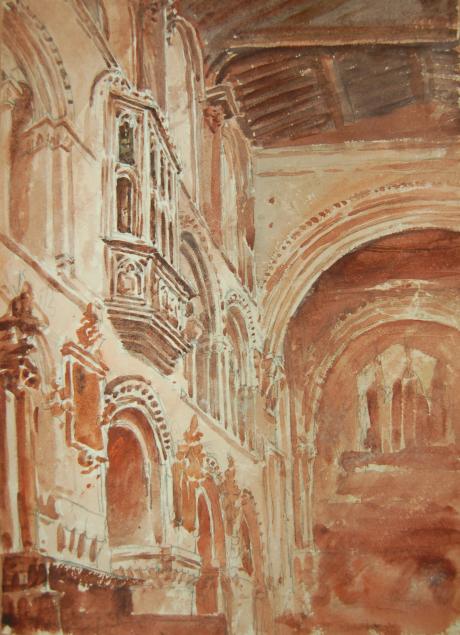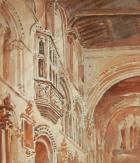on the reverse "St Bartholomew / London"
The Priory Church of St Bartholomew the Great, sometimes abbreviated to Great St Bart's, is an Anglican church in West Smithfield within the City of London. The building was originally founded as an Augustinian priory in 1123 and adjoins St Bartholomew's Hospital of the same foundation. Founded in 1123 by Rahere, a prebendary of St Paul's Cathedral and an Augustinian canon regular, its establishment is recorded as being in gratitude for his recovery from fever. His fabled miraculous return to good health contributed to the priory gaining a reputation for curative powers and with sick people filling its aisles, notably on 24 August (St Bartholomew's Day).
The surviving building originally comprised part of a priory adjoining St Bartholomew's Hospital, but while much of the hospital survived the Dissolution of the Monasteries about half of the priory's church was ransacked before being demolished in 1543. Its nave was pulled down up to the last bay but the crossing and choir survive largely intact from the Norman and later Middle Ages, enabling its continued use as a parish church. Part of the main entrance to the church remains at West Smithfield, nowadays most easily recognisable by its half-timbered Tudor frontage, which was erected by the post-Reformation patron of the advowson, Lord Rich, Lord Chancellor of England (1547-51).From there to its west door, the church path leads along roughly where the south aisle of the nave formerly existed. Very little trace of its monastic buildings now survive, although parts of the cloister now house a café. St Bartholomew the Great is so named to distinguish it from its neighbouring smaller church of St Bartholomew the Less which was founded at the same time within the precincts of St Bartholomew's Hospital to serve as the hospital's parish church and occasional place of worship. The two parish churches were reunited in 2012 under one benefice.
Having escaped the Great Fire of London of 1666 the church fell into disrepair, becoming occupied by squatters in the 18th century. W. G. Grace, however, was one famous congregant before its restoration in the late 19th century,when it was rebuilt under Sir Aston Webb's direction. During Canon Edwin Savage's tenure as rector the church was further restored at the cost of more than £60,000. The Lady chapel at the east end had been previously used for commercial purposes and it was there that Benjamin Franklin worked for a year as a journeyman printer. The north transept was also formerly used as a blacksmith's forge in order to make ends meet. The Priory Church was one of the few City churches to escape damage during the Second World War and, in 1941, was where the 11th Duke of Devonshire and the Hon Deborah Mitford were married.
The poet and heritage campaigner Sir John Betjeman kept a flat opposite the churchyard on Cloth Fair. Betjeman considered the church to have the finest surviving Norman interior in London. In 2005 a memorial service was held for Sir William Wallace, on the 700th anniversary of the Scottish hero's execution, organised by the historian David R. Ross. Charitable distributions in the churchyard on Good Friday continue. A centuries-old tradition established when twenty-one sixpences were placed upon the gravestone of a woman stipulating that the bequest fund an annual distribution to twenty one widows in perpetuity, with freshly-baked hot cross buns nowadays being given not only to widows but others. The church was designated a Grade I listed building on 4 January 1950. In April 2007 it became the first Anglican parish church to charge an entrance fee to tourists not attending worship. The oriel window was installed inside St Bartholomew the Great in the early 16th century by Prior William Bolton,allegedly so that he could keep an eye on the monks. The symbol in the centre panel is a crossbow "bolt" passing through a "tun" (or barrel), a rebus or pun on the name of the prior.
William Camden wrote: “It may be doubtful whether Bolton, Prior of St Bartholomew, in Smithfield, was wiser when he invented for his name a bird-bolt through his Tun, or when he built him a house upon Harrow Hill, for fear of an inundation after a great conjunction of planets in the watery triplicity".
St Bartholomew the Great is the adopted church of various City livery companies hosting services throughout the year: the Worshipful Company of Butchers (one of the seven oldest livery companies), the Worshipful Company of Founders (whose Hall abuts the church), the Worshipful Company of Haberdashers (incorporated 1448 and No. 8 in City precedence), the Worshipful Company of Fletchers, the Worshipful Company of Farriers (incorporated 1674), the Worshipful Company of Farmers (incorporated 1955). The more recently established Worshipful Company of Information Technologists (incorporated 1992), the Worshipful Company of Hackney Carriage Drivers (incorporated 2004) and the Guild of Public Relations Practitioners (incorporated 2000) also have an association with St Bartholomew's.
The church served as the chapel of the Imperial Society of Knights Bachelor before the establishment of the society's permanent chapel in St Paul's Cathedral in 2005.
John Louis Petit was born at Ashton-under-Lyne, Lancashire, son of John Hayes Petit. He was educated at Eton, and contributed to the "Etonian". He was elected to a scholarship at Trinity College Cambridge in 1822, graduated BA in 1823 and MA in 1826, and on 21st June 1850 he was admitted "ad eundem" at Oxford. He took holy orders in 1824, but undertook no parochial work. Petit showed a taste for sketching in early years. His favourite subject was old churches, and a great part of his life was spent in visiting and sketching them. In 1839 he made his first extensive tour of the continent. The results appeared in his "Remarks on Church Architectire" (1841, 2 vols which had illustratuions. It was followed in 1846 by "Remarks on Church Architectural Character" Royal folio format.In the same year Petit published a lecture which he had delivered on 24th Feb 1846 to the Oxford Society for promoting the study of Gothic Architecture, under the title "Remarks on the Principles of Gothic Architecture as applied to ordinary Parish Churches". It was succeeded by "Architectire of Tewksbury Abbey Church". Royal svo 1846. " Architectural notes in the neighbourhood of Cheltenham"and "Remarks on Wimborne Minster", 1847. "Remarks on Southwell Minster". With numerous good illustrations. 1848. "Architectural Notices relating to Churches in Gloucestershire and Susse". 1849. "Architectural Notices of the Curious Church of Gillingham.Norfolk". And an "Account of Sherborne Minster". 1850. In 1852 Petit published an account of Brinkburn Priory". In 1854 appeared Petit's principal work. "Architectural Studies in France", imperial SVO. It was beautifully illustrated with fine woodcuts and facsimiles of anastic drawings by the author and his companion, Professor Delamotte. It showed much learningand observation, and threw light upon the formation of Gothic in France, and on the differences between English and French Gothic. A new edition , revised by Edward Bell, FSA, with introduction, notes and index, appeared in 1890. The text remained unaltered but the illustrations were reduced in size, and a few added from Petit's unused woodcuts. In 1864-65 he travelled in the East and executed some striking drawings. He died in Lichfield on 2 Dec 1868, from a cold caught while sketching and was buried in St Micheal's Churchyard. Petit was the founder of the British Archealogical Institute at Cambridge in 1844. He was also FSA, an honoury member of the Institute of British Architects, and a governor of Christ's hospital.


